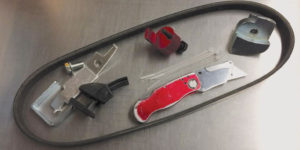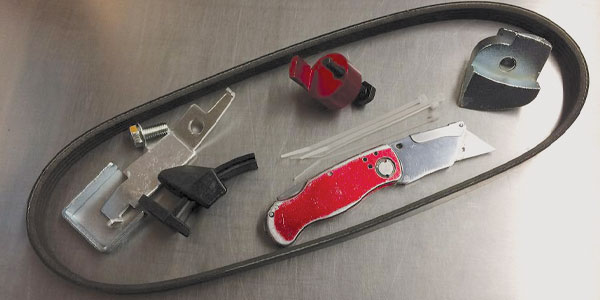 Stretch-fit serpentine belts are the latest product in the evolution of the accessory drive belt. Similar in external appearance to a conventional serpentine belt, these belts have a unique internal construction that allows them to be self-tensioning. Eliminating the automatic tensioner assembly allows automotive engineers to design more compact accessory drives, and to reduce the number of components sharing the primary belt drive.
Stretch-fit serpentine belts are the latest product in the evolution of the accessory drive belt. Similar in external appearance to a conventional serpentine belt, these belts have a unique internal construction that allows them to be self-tensioning. Eliminating the automatic tensioner assembly allows automotive engineers to design more compact accessory drives, and to reduce the number of components sharing the primary belt drive.
A conventional serpentine belt is constructed with an inner core of aramid fiber cord, which helps prevent stretching, while stretch belts use polyamide tensile cords, which are engineered with a specific amount of elasticity, creating the stretch-fit feature that maintains proper tension once installed. It can be thought of as a “controlled” or “constant” stretch.
OEM stretch-fit belts began to appear about 15 years ago, as a separate belt drive powering water pumps, A/C compressors or power steering pumps. These are usually very short belts, designed for two, three, or four-point routing. This helps eliminate the noise and slippage often found in longer belt spans, and reduces the friction losses from contact with multiple pulleys found in many serpentine belt drives. The result is a more efficient and quieter belt drive. Shorter belts require less tension to prevent slippage, so self-tensioning belts are well-suited to these applications. Generally, any modern belt drive connecting a limited number of pulleys, and having no automatic tensioner, is likely a “stretch” application.
Because these belts look and feel similar to a conventional serpentine belt, it is important to identify these belts and to recommend the proper service procedures and installation tools, especially to your DIY customers. Aftermarket belt manufacturers will add identifiers to their part numbering to indicate that the belt is a stretch-fit application, to prevent confusion between these belts and traditional serpentine belts of the same dimensions. “E” for “elastic”or “S” for “stretch” are commonly used by manufacturers as part of the numbering system to identify their stretch-to-fit belts. The “packaged” length of stretch belts is slightly shorter than their “installed” length, and installers should not select these belts based on advertised dimensions alone.
Stretch belts are designed to be a “one-time use” component. In most cases, servicing these belts begins with the technician removing the original belt by cutting it off with diagonal cutters or a utility knife. If the belt is original, or if the vehicle’s prior service history is unknown, it is best to recommend a new belt. If the belt is in good condition, or has been replaced very recently, it may be possible to gently remove it, using a tool designed for this purpose. Installation of the new belt requires the technician to “walk” the belt onto the pulley, and belt installation tools are a popular new category, available from many belt manufacturers as well as tool companies. The installation tool is attached over the outer lip of the largest pulley in the belt drive (or sometimes just the most accessible!), and the pulley is rotated until the belt is seated entirely in its grooves. Many of these belts are very narrow (3 or 4 ribs), so sometimes a small zip-tie can be used to keep the belt in place as it is started over the pulley.
Whenever selling stretch belts, these service items, as well as the serpentine belt, its tensioner, and idler pulleys also can be recommended for the most complete repair.








